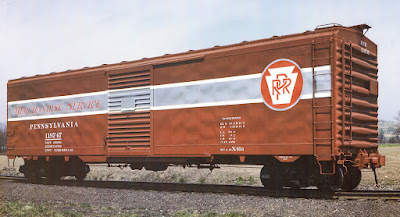 |
| crop of "general view of part of Galewood Yard, Chicago, Ill.," [Milwaukee Road,] April, 1943, Jack Delano photo, FSA-OWI Collection, Library of Congress, Call number LC-USW36-619 |
Roof paint failure (peeling, flaking paint on galvanized roof sheets) is one of those parts of freight car weathering that has taken off in recent years. For my purposes (and those of this blog) I am referring to this phenomenon as it occurred to roofs on freight cars of the 'teens through the 50s, realizing that the effects of weather, etc. on more modern cars is a different subject in many ways. The first thing that I want to emphasize very strongly is that I have looked at lots and lots of period photos where roofs are visible and can report one important fact: paint failure was not universal and, in fact, was not terribly common. Granted, in a yard shot, you can discern the effect on one or two cars out of scores of cars, but it is not evident on every car or even anything approaching a majority. So, if the subject of weathering already causes you angst, I suggest you move along to other facets of weathering and lose no sleep. What am I looking to accomplish in this post is to share some examples of what the prototype effect looked like to aid your efforts, should you choose to model this effect. I recently tried one method that I covered in the final installment on my model of the New Haven 1937 AAR box car.
John Golden has done some incredible work in this area using the "salt" technique, and it is really the standard to which I am working, albeit while stumbling through. many techniques and growing pains along the path. You can read John's excellent blog via this link. He also shared his paint failure techniques here (link.) Charlie Duckworth has also produced some quite credible results. His work can be found on the Steam Era Freight Car list at groups.io or on facebook. Military modelers use various chipping and masking techniques (using hair spray and rubber cement among other things) to represent paint removal by scuffing and wear, although many of the same principles translate to roof paint failure. Good luck!
 |
| Utah Rails web site |
This image shows some subtle effects on a Rio Grande 12-panel box car. To me, it is a good illustration of what I want to achieve on a few cars... the presence of paint failure, but not a completely degraded surface
 |
| Buffalo, New York, NYCSHS Collection, courtesy of Joe Collias |
This re-roofed New York Central USRA-design box car demonstrates that some times a small amount of failure is all that is needed when weathering
 |
| cropped from Neg no. 45882, Spencer, North Carolina, Standard Oil of New Jersey, Ekstrom Library, University of Louisville |
The roof on this SP single sheathed car from the B-50-13 & -14 family displays a nice mix of failure and weathering that would be a good prototype to emulate
 |
| cropped from Neg no. 50862, Newark, New Jersey, Standard Oil of New Jersey, Ekstrom Library, University of Louisville |
While this image is a very tiny snippet (it was all that was included in the overall yard shot,) it does provide a good look at the shape of paint failure in the center of a roof panel
 |
| Missouri Pacific freight house, St. Louis, May, 1946, Joe Collias Collection |
This is an extreme example, an it's on a more vintage 36-foot double sheathed Boston & Albany car. Note the variety as some panels show very little failure and others are 75-80% devoid of paint
 |
| Columbus, Georgia, crop of image no. CG-2590, Central of Georgia Railway Historical Society |
I like this image as it's another that illustrates how eve na small amount of paint failure can be quite realistic
 |
| Los Angeles, Morris Abowitz |
Color images are always a great tool for weathering. Again, note the randomness of the failure on some panels, but not others on these two roofs
 |
| crop if image from Kheel Center for Labor Management Documentation and Archives, Cornell University |
This image is the one I will use to guide my efforts when I build my Resin Car Works kit of this prototype. I will continue to share my efforts here so stay tuned (you can receive updates by following this blog by adding your email address using the box at the top of the page)





























































